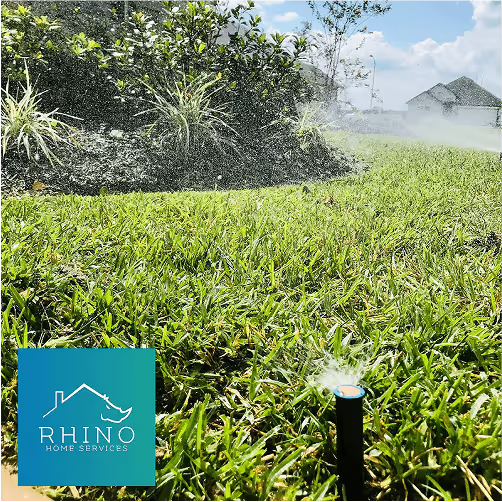How to Water Your Lawn with a Sprinkler System (2025 Guide)

Quick Answer
Watering your lawn efficiently requires the right timing, duration, and equipment according to the U.S. Environmental Protection Agency (EPA) Most lawns need 1 to 1.5 inches of water per week, best delivered in the early morning using an automated or smart sprinkler system. Adjust your schedule based on grass type, soil, and weather to avoid over- or under-watering.
Understanding Lawn Watering Basics
A sprinkler system can make watering easy and consistent, but only when used correctly. Overwatering leads to shallow roots and fungal disease, while underwatering leaves grass dry and stressed. The goal is to achieve deep, infrequent watering that encourages strong root growth.

How Much Water Does Your Lawn Need?
- Most lawns: 1–1.5 inches per week (including rainfall)
- Cool-season grass (e.g., fescue, bluegrass): prefers deep watering twice weekly
- Warm-season grass (e.g., Bermuda, Zoysia, St. Augustine): tolerates less frequent watering
Pro Tip: Use a rain gauge or tuna cans placed around your yard to measure sprinkler output. Once you reach 1 inch of water, your lawn has enough for the week.
Setting the Ideal Lawn Watering Schedule
Best Time of Day to Water
Water early morning (4-9 a.m.), when temperatures are cooler and wind is calm, as recommended by Clemson University Cooperative Extension. Avoid midday watering, which causes evaporation loss, and late-night watering, which promotes disease.
Signs of Overwatering vs. Underwatering
Overwatering Signs
- Mushy or soggy soil
- Fungal growth or mushrooms
- Grass turns yellow or weak
- Water runoff or puddles after irrigation
Underwatering Signs
- Lawn looks dull, grayish, or bluish
- Footprints remain visible after walking
- Soil is hard or cracks easily
- Grass blades wilt or curl
Maintaining the right balance helps grass build deeper roots and reduces your water bill, according to Texas A&M AgriLife Extension.
Smart Irrigation Controllers
Smart irrigation controllers automatically adjust watering schedules based on real-time weather, soil moisture, and evapotranspiration rates, soil moisture, and evapotranspiration rates. Many models connect to Wi-Fi and pause watering when rain is forecasted.
Benefits of Smart Controllers:
- Save 20–50% on water use
- Prevent overwatering during rain or humidity
- Monitor your system from a mobile app
- Comply with local watering restrictions
Popular models: Rain Bird ARC WiFi, Rachio 3, Hunter Hydrawise.
How to Measure Sprinkler Output
- Place 4–6 flat containers (e.g., tuna cans) across your lawn.
- Run sprinklers for 15 minutes.
- Measure the water depth in each can.
- Multiply by 4 to calculate inches per hour.
If you collect 0.25 inches in 15 minutes, your system applies 1 inch/hour—ideal for scheduling watering cycles.
New Lawn Watering Tips
Newly seeded or sodded lawns require frequent, shallow watering:
- Water lightly 2–3 times daily until grass germinates.
- Once growth reaches 2–3 inches, reduce to once per day.
- After 3 weeks, transition to deeper, less frequent watering.
- Avoid heavy foot traffic during early growth stages.
How Soil Type Affects Irrigation
- Sandy soil: Drains quickly; needs shorter, more frequent watering.
- Loamy soil: Ideal balance; holds moisture well with moderate watering.
- Clay soil: Holds water longer; water slowly to prevent runoff.
Cycle and Soak Method: Run sprinklers in multiple short cycles (e.g., 10 mins on, 30 mins off) to help water penetrate dense or sloped soils.
Final Takeaway
A well‑planned watering schedule and properly calibrated sprinkler system keep your lawn lush while conserving water. Combine early‑morning watering, weather‑responsive tech, and soil‑based adjustments to ensure every drop counts.
Get a Free Estimate
Want a lush lawn without dragging hoses? Our licensed, insured Houston team installs efficient, code‑compliant systems, backed by a 2‑year warranty and a friendly walkthrough so you’re confident from day one.
Get a Free EstimateFrequently Asked Questions
Typically 15–30 minutes per zone, depending on sprinkler type, soil, and grass variety.
Water 1–2 times per week, delivering about 1 inch total. Adjust based on temperature and rainfall.
Step on the grass, if footprints remain visible or the color looks dull gray, it’s time to water.
Morning watering is best because it reduces evaporation and fungal disease risk.
They automatically adjust irrigation based on local weather and soil data, preventing unnecessary watering.




